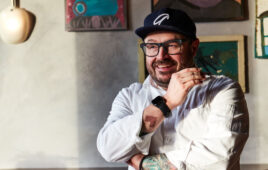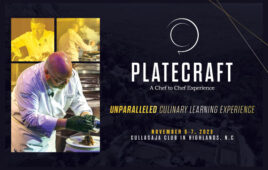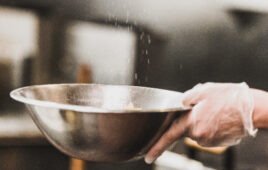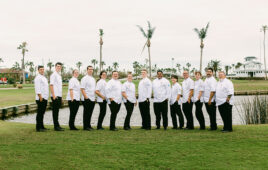During a visit to Peoria, Ill., in 1910, President Theodore Roosevelt declared that city’s Grandview Drive to be “the world’s most beautiful drive.” Along that drive just north of the city, in Peoria Heights, were the 27 acres of the Country Club of Peoria, established in 1897. With its panoramic view of the Illinois River, the CC of Peoria’s 500 members and their guests enjoy that same experience today.
The CC of Peoria has many amenities that include an outstanding Food and Beverage department led by Executive Chef James Kremer, CEC. After a promotion last year, Chef Kremer now doubles as the club’s Food and Beverage Manager, directing a staff of 58 employees. Even with an incredibly busy schedule, Chef Kremer was kind enough to talk to us about his extensive resume and industry experience.
CHEF PROFILE
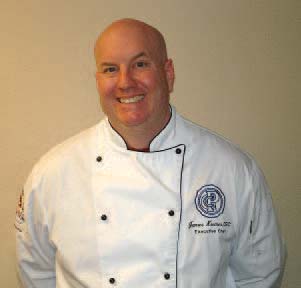 Current Position: Executive Chef/Food and Beverage Manager, Country Club of Peoria, Peoria Heights, Ill. (2010-Present)
Current Position: Executive Chef/Food and Beverage Manager, Country Club of Peoria, Peoria Heights, Ill. (2010-Present)Previous Experience:
- Executive Chef, Montgomery Country Club, Montgomery, Ala. (2007-2010)
- Executive Chef, The Landings Club, Savannah, Ga. (2004-2007)
Education: Graduated with Honors, French Culinary Institute, New York
Certificates:
- Certified Executive Chef
- Accredited Certification Evaluator, American Culinary Association
Awards and Professional Affiliations:
- President, Savannah Chefs and Cooks Association
- Winner, Kiwanis Club Chili Cook-off, Savannah, Ga. (2004-2006)
Q. Chef, after coming to CC of Peoria as Executive Chef at the start of 2010, you were given the added duties of F&B Manager in September 2011. What have been some of the biggest challenges involved with learning to handle these dual roles for a club operation that grosses over $4 million a year?
A. The greatest challenge has been dividing my time between the front and back of the house. My core groups of chefs and front-of-house managers have been fantastic during the transition period. In a club that stays as busy as ours, having the right people in the right positions is vitally important to our overall success. I conduct a weekly front-of-house staff meeting where I try to lay out all expectations for upcoming club events and service to all of my key managers, and they have been fantastic.
Knowing where and when I need to be, either in the kitchen or dining rooms, has been challenging. I’m lucky to have a great General Manager, Gary Behan, CCM, who has mentored me during this time. As any great chef knows, having that key person who can help you along while you build the essential skills you need to succeed will ultimately help you become a better Chef/Manager.
Membership support of the entire food-and-beverage department is also extremely important. I try to get as much member input, as well as listen to all member concerns about food and service, as I can. I also sit on the House Committee, Entertainment Committee and the Wine Committee. The feedback and suggestions that we get from members really guide us along the way and help us succeed—and the proof of that is that membership satisfaction is at an all-time high.
Peoria is a great city that is home to many large employers, such as Caterpillar, Maui Jim, Bradley University and several large hospitals. We often see key political and business figures here, along with our 500 families. Our members and guests are well-traveled and know good food and service, and they expect both at the club. We make sure we deliver.
Q. When you take control of a club F&B operation, what are the main areas of focus to raise the level of service right off the bat?
A. Training, training…and training.
I like to run my kitchens as learning kitchens. I make sure every cook has the skill sets needed to perform the job(s) they will need to do every day.
My menus are based on scratch cooking and sustainability. With all of the convenience products out there, many of our young culinarians are losing the ability to truly cook. I make sure they have the ability to come to work and learn how to really cook. They love it, and in return I have very low turnover and a group of cooks who like coming to work every day. And membership gets a higher-quality product, so it’s a win all around.

 Chef Kremer and his staff are given frequent opportunities to get their creative culinary juices flowing, through events such as the annual Maui Jim golf event, which ends with a poolside luau for 300 players and guests.
Chef Kremer and his staff are given frequent opportunities to get their creative culinary juices flowing, through events such as the annual Maui Jim golf event, which ends with a poolside luau for 300 players and guests.
My cooks with more experience get the chance to teach those skills to someone; this not only reinforces what they know, but they get the satisfaction of seeing that employee grow and succeed, and now have a part in the club’s success.
I also try to push ACF certification and competitions with my cooks, with the goal to one day have every one of my cooks certified at some level. I hope to have my Sous Chef take his CEC practical early next year and finish his requirements before the end of the year.
I also developed—you could say “borrowed”—a program from one of the Midwest’s greatest chefs. The Excellence Program that Charlie Trotter used at his namesake restaurant in Chicago is the same one I use for my staff. It doesn’t allow any exceptions and calls for a total commitment to providing the best food and service while striving for excellence within one’s self.
It can be a difficult task to start a program with such lofty goals, but once everyone gets the mindset and sets the bar that high, it has fantastic results. Everyone defines excellence a little differently, but at the end of the day the food and service we provide only gets better.
Another thing that I have come across is stale or outdated menus. As a chef of a high-tier country club, I have a responsibility to stay current with trends and styles. Continuing education and being active in groups like the American Culinary Federation and Club Managers Association of America definitely helps. I also use food and trade shows as great ways to network and make it a point to know what is working, or not working, at other clubs.
Club chefs need to change menus and listen to their membership as much as they can. Spending a little time in the dining rooms, getting to know member likes and dislikes, goes a long way to help make decisions on what to put on menus. Once members get to know you, they will be upfront and honest with you and freely provide feedback, good and bad. They, too, only want what is best for their club—and that is what we are here to do.
Q. Maui Jim, the very successful sunglasses company, has its mainland U.S. headquarters in Peoria, and you do an incredibly innovative golf event for them each year. Tell us about what’s involved for the F&B portion.
A. I have been very fortunate in my career as a club chef to do some amazing weddings, parties and golf outings; I’ve seen some really cool things and have been able to do great events like “Pigs and Pinot.” But nothing I’ve ever done has been as grand as what we do every year for our Maui Jim golf event.
Vodka-Poached Shrimp with Bloody Mary Sauce
| Amt | Ingredient |
| 24 | peeled and deveined jumbo raw shrimp, with tails |
For the Poaching Liquid:
| Amt | Ingredient |
| 1/2 cup | vodka |
| 1/2 | lemon |
| 2 tsp. | kosher salt |
| 1/2 tsp. | black peppercorns |
- Combine first four ingredients in a large saucepan; bring to a boil over mediumhigh heat.
- Add shrimp, and cook 2 to 3 minutes, or until shrimp turn pink. Drain. Chill shrimp 1 hour.
- Serve with Bloody Mary Cocktail Sauce (see below)
For the Bloody Mary Cocktail Sauce:
| Amt | Ingredient |
| 1 cup | ketchup |
| 1/2 cup | chili sauce |
| 3 tbsp. | prepared horseradish |
| 1 tbsp. | vodka |
| 2 tbsp. | fresh lemon juice |
| 1 1/2 tsp. | Worcestershire sauce |
| 1 tsp. | hot sauce |
| 1/4 tsp. | celery salt |
| 1/4 tsp. | freshly ground black pepper |
- Combine, mix well, and chill
The tournament itself supports the Children’s Home here in Peoria and is their biggest fundraiser. We start off the night before at a member’s home here on Grandview Drive, where we do a welcoming party for all players and sponsors with seafood displays, action stations, magicians walking around doing tricks and three golf professionals from the Seniors tour, who also play with the guests during the tournament the next day. Craig Stadler, Morris Hatalsky and Dave Stockton have been just some of the pros who have come out every year to support this event.
We start planning months in advance for the tournament, and try every year to outdo the last. The tournament itself starts at 6:00 a.m. with breakfast for the players and volunteers. From there we go to an on-course buffet with food stations and bars set up at 12 holes, as well as a grandstand where VIP guests can watch the action. Many of the stations are live, chef-attended grills serving everything from sliders to pan-seared U-10 diver scallops.
When the golf ends, the party begins back at the club, with a poolside luau for 300 players and guests. The night ends around midnight with a very tired but proud staff.
 An emphasis on healthful options at CC of Peoria is reflected in buffet displays as well as low-calorie menus for appetizers, dinners and desserts.
An emphasis on healthful options at CC of Peoria is reflected in buffet displays as well as low-calorie menus for appetizers, dinners and desserts.
As a chef who was brought up in the hospitality industry from a young age, I am used to giving back—in fact, I don’t know of too many professional groups that give as much time to charity as chefs do. So I love this event and I am so impressed with the Maui Jim company for its dedication and commitment throughout the entire year, with this and other fundraisers they do for other local charities. It’s a company that has committed itself to excellence, and I am proud to be a part of that effort.
Q. Chef, as we all know, smaller portions and lighter, healthier options can attract members to the club on a nightly basis. Tell us how you engineered this concept through your low-calorie menus.
A. This concept has taken off bigger than I ever would have imagined. Last year, I took myself through a personal quest to lose weight and be healthier, after attending a national ACF conference and hearing about the “Chefs Move to School” program that puts local chefs into schools in their areas, to teach kids and their families about healthy eating.
I sat there and listened while being, as many chefs can get to be, very obese and out of shape. How could I stand in front of anyone and talk about healthy eating? So I started eating healthy, with smaller portions, and exercising every day.
 The Country Club of Peoria, established in 1897, has 500 members in a city that is home to many large employers, including Caterpillar and Bradley University.
The Country Club of Peoria, established in 1897, has 500 members in a city that is home to many large employers, including Caterpillar and Bradley University.
Like most chefs who have small kids, when you have time off you’re usually running the kids to sports and school events, and aren’t at home planning what’s for dinner. So like many families we eat out a lot, and when you do that it’s more difficult to watch calories and fat intake or want to eat salads.
I figured some of our membership might be going through the same difficulties as I was when they came out to the club to eat. So I wanted to make it easier for them to make healthy choices, too.
I developed a menu that we run every meal period, with appetizers and desserts under 100 calories, and dinners under 500 calories, and with all nutritional information included. The recipes are developed just like the ones we use on all other menus—flavor and taste are the first thought, and then we figure out how to “trim the fat.” For example, we developed a vodka-poached shrimp with Bloody Mary cocktail sauce (see recipe, pg. 39) as an appetizer that’s very flavorful, but still low-calorie.
 For an extended version of this
For an extended version of thisconversation with Chef James Kremer and his recipe for Skuna Bay Salmon and Tomato Salad (shown) go to
clubandresortbusiness.com
Acceptance has been tremendous— some nights, low-cal dishes will now account for up to 50% of the menu mix. We are now getting many members to come out more often, and many will still order an appetizer, entrée and dessert, bringing the bill up to that of an entrée off the regular lunch or dinner menu. So these menus have kept revenues and check averages high—and at the same time, some of our older members have told me that the portion size is perfect for them.
It also helps that I can now literally stand in front of the members as “living proof” of the benefits of a healthier approach to dining (to date, I have lost over 100 pounds, and have run in two 5k races with my family). Last month, a member told me that I inspired him to lose weight. I cannot tell you how good that feels to hear, and I am proud that my menu has helped to change the eating habits and improve the lives of members.
We are the keepers of the gate when it comes to feeding our members and guests and helping them choose healthy, sustainable food options. These menus give them that choice, and show that healthy food does not have to be bland—it can be great, and fun to create.
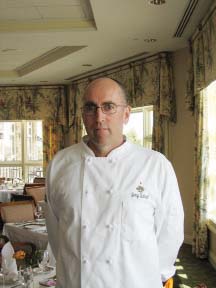 Jerry Schreck: is a member of the Club & Resort Business Advisory Board. Know someone you’d like to have Jerry interview for a future “Chef to Chef” conversation? Send your suggestions to [email protected]
Jerry Schreck: is a member of the Club & Resort Business Advisory Board. Know someone you’d like to have Jerry interview for a future “Chef to Chef” conversation? Send your suggestions to [email protected]
RUNOVER
Skuna Bay Salmon and Tomato Salad
| Amt | Ingredient |
| 4 | 6-oz. portions of Skuna Bay salmon |
| 2 | ripe heirloom tomatoes |
| 4 | roasted baby beets |
| 3 tbsp. | extra-virgin olive oil |
| juice | 1 lemon |
| 3 ozs. | micro beets |
| 2 ozs. | micro watercress popcorn shoots |
| 4 ozs. | truffle honey goat cheese (see recipe below) balsamic reduction salt and pepper |
For the Honey Truffle Goat Cheese Spread:
| Amt | Ingredient |
| 1 lb. | goat cheese |
| 2 tbsp. | truffle cream |
| 1.5 tbsp. | honey |
| 2 tbsp. | extra-virgin olive oil |
- Soften goat cheese, add remaining ingredients, and mix well by hand
- Season Skuna Bay salmon with salt and pepper; pan-sear on medium-high heat for 3 to 4 minutes on each side, until fish is cooked medium. Remove and let rest for 1 minute.
- Slice and season tomatoes with salt, pepper and olive oil; place truffled goat cheese on each slice and beet quarter on each piece.
- Plate salmon and top with micro beets and watercress,
drizzle with balsamic and olive oil, and garnish with
popcorn shoots.
Q. Chef, I have heard so many good things about the French Culinary Institute in the past few years. As an alum who keeps tabs on what goes on there today, what separates their curriculum from the CIAs and Johnson & Wales of the world?
A. The French Culinary Institute—now the International Culinary Center—will always be a special place for me. Dorothy Hamilton started an amazing program and from the start made sure she had the best. With Deans of the school like Andre Soltner, Alain Sailhac, Jacques Pepin and Jacques Torres, that is a good way to start, for sure.
The chef instructors are from some of the best restaurants in New York, and they work one-on-one with every student in a smaller class size than most schools. Every student is cooking from day one until they graduate.
The Alumni list is amazing for such a young school: it includes Dan Barber, David Chang, Wylie Dufresne and Bobby Flay, just to name a few. The chefs and celebrities who would walk though the kitchens were outstanding— Martin Scorsese walked in to say hello to one of my instructors during my first week!
The total immersion in French cooking taught by amazing instructors and in a city like New York is a recipe for success. I have taken classes at CIA and they have a top-notch program with amazing facilities and instructors as well. Having worked both under and with graduates of both CIA and Johnson and Wales, I can say nothing but good things about their schools. They just are not FCI or in New York—but then I am a little biased, to say the least.


